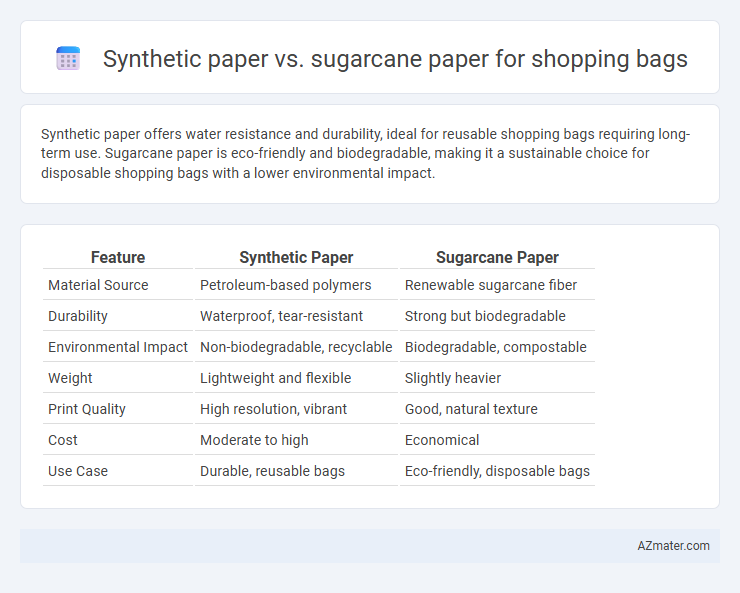Synthetic paper offers water resistance and durability, ideal for reusable shopping bags requiring long-term use. Sugarcane paper is eco-friendly and biodegradable, making it a sustainable choice for disposable shopping bags with a lower environmental impact.
Table of Comparison
| Feature | Synthetic Paper | Sugarcane Paper |
|---|---|---|
| Material Source | Petroleum-based polymers | Renewable sugarcane fiber |
| Durability | Waterproof, tear-resistant | Strong but biodegradable |
| Environmental Impact | Non-biodegradable, recyclable | Biodegradable, compostable |
| Weight | Lightweight and flexible | Slightly heavier |
| Print Quality | High resolution, vibrant | Good, natural texture |
| Cost | Moderate to high | Economical |
| Use Case | Durable, reusable bags | Eco-friendly, disposable bags |
Introduction to Eco-Friendly Shopping Bag Materials
Synthetic paper offers durability and water resistance but relies heavily on plastic polymers, raising environmental concerns. Sugarcane paper, made from renewable biomass byproducts, provides a biodegradable and compostable option that reduces reliance on fossil fuels. Choosing sugarcane paper for shopping bags supports sustainable packaging initiatives and minimizes carbon footprint compared to synthetic alternatives.
What is Synthetic Paper?
Synthetic paper is a durable, waterproof material made from plastic resins such as polypropylene or polyethylene, designed to mimic the look and feel of traditional paper while offering enhanced strength and tear resistance. Unlike sugarcane paper, which is biodegradable and made from agricultural waste, synthetic paper provides superior longevity and moisture resistance, making it ideal for reusable shopping bags in wet or rugged environments. Its chemical stability and printing compatibility allow vibrant, long-lasting graphics, contributing to high-quality branding on shopping bags.
What is Sugarcane Paper?
Sugarcane paper is made from bagasse, the fibrous residue left after extracting juice from sugarcane stalks, offering an eco-friendly alternative to traditional paper. Unlike synthetic paper, which is typically composed of plastic polymers such as polypropylene, sugarcane paper is biodegradable and compostable, reducing environmental impact. Its natural fibers provide durability suitable for shopping bags while supporting sustainable agricultural practices.
Production Process: Synthetic vs Sugarcane Paper
Synthetic paper is produced through a polymer extrusion process using polypropylene or polyethylene resins, resulting in a durable, water-resistant material ideal for reusable shopping bags. Sugarcane paper is made from bagasse, the fibrous residue left after extracting juice from sugarcane, and undergoes pulping, bleaching, and pressing to create an eco-friendly, biodegradable paper option. The production of sugarcane paper involves renewable agricultural waste, reducing reliance on fossil fuels compared to the synthetic paper's petrochemical-based manufacturing.
Durability and Strength Comparison
Synthetic paper offers superior durability with high resistance to tearing, water, and chemicals, making it ideal for heavy-duty shopping bags. Sugarcane paper, though eco-friendly and biodegradable, has moderate strength and is more prone to wear and moisture damage under heavy loads. For long-lasting and robust shopping bags, synthetic paper outperforms sugarcane paper in both tensile strength and durability.
Environmental Impact: Synthetic vs Sugarcane
Synthetic paper, typically made from petroleum-based plastics, poses significant environmental challenges due to its non-biodegradability and reliance on fossil fuels, leading to long-term pollution and carbon emissions. In contrast, sugarcane paper, derived from renewable agricultural waste, offers a more sustainable alternative by being biodegradable and having a lower carbon footprint throughout its lifecycle. The choice between synthetic and sugarcane paper for shopping bags directly impacts waste management effectiveness and overall ecological sustainability.
Cost Analysis: Affordability and Scalability
Synthetic paper offers higher durability but comes at a significantly elevated production cost compared to sugarcane paper, which is more affordable and benefits from renewable resource availability. Sugarcane paper's scalability is enhanced by abundant agricultural waste feedstock, reducing raw material expenses and enabling competitive pricing for mass production. The cost-efficiency of sugarcane paper makes it a preferred option for sustainable shopping bags in large-scale manufacturing.
Printing and Customization Options
Synthetic paper offers superior print quality with vibrant colors and sharp details, making it ideal for high-resolution graphics and intricate designs on shopping bags. Sugarcane paper, being eco-friendly, supports standard printing techniques but may have limitations in color vibrancy and fine detail precision compared to synthetic paper. Customization options on synthetic paper include diverse finishes and textures, while sugarcane paper emphasizes sustainability-focused inks and natural aesthetics.
Biodegradability and Recycling Potential
Synthetic paper offers high durability and water resistance but poses significant challenges in biodegradability, often requiring specialized recycling processes that are not widely accessible. Sugarcane paper, derived from renewable agricultural waste, provides excellent biodegradability and is more easily recyclable within existing paper recycling streams, reducing environmental impact. Choosing sugarcane paper for shopping bags supports sustainable waste management practices and decreases landfill contributions compared to synthetic paper alternatives.
Which is Better for Shopping Bags: Synthetic or Sugarcane Paper?
Synthetic paper offers superior durability, water resistance, and tear strength, making it ideal for reusable shopping bags that require longevity. Sugarcane paper, derived from bagasse, is eco-friendly and biodegradable, appealing to environmentally conscious consumers but may lack the robustness needed for heavy shopping loads. For shopping bags, synthetic paper is better suited when durability is a priority, while sugarcane paper excels in sustainability for lightweight use.

Infographic: Synthetic paper vs Sugarcane paper for Shopping bag
 azmater.com
azmater.com